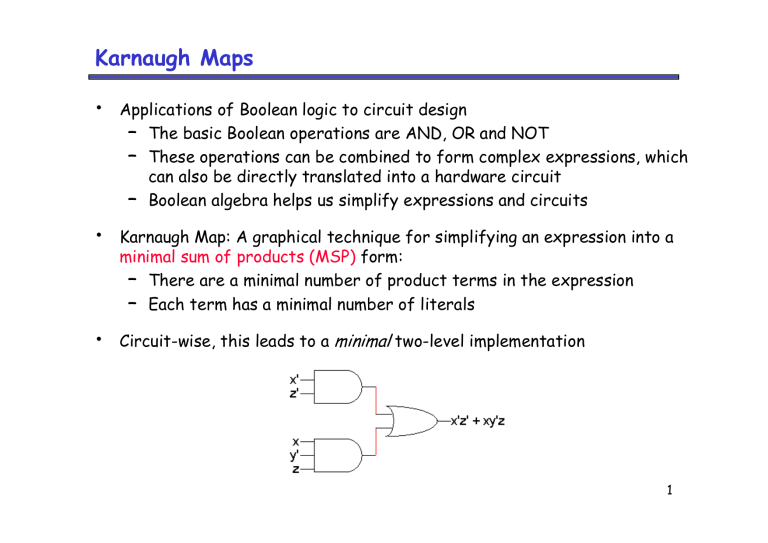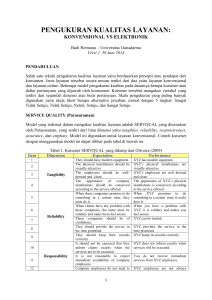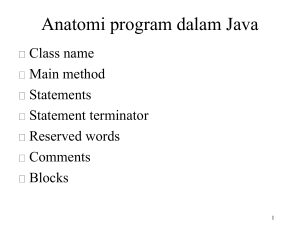
Karnaugh Maps • Applications of Boolean logic to circuit design – The basic Boolean operations are AND, OR and NOT – These operations can be combined to form complex expressions, which can also be directly translated into a hardware circuit – Boolean algebra helps us simplify expressions and circuits • Karnaugh Map: A graphical technique for simplifying an expression into a minimal sum of products (MSP) form: – There are a minimal number of product terms in the expression – Each term has a minimal number of literals • Circuit-wise, this leads to a minimal two-level implementation 1 Review: Minterm • A product term in which all the variables appear exactly once, either complemented or uncomplemented, is called a minterm • A minterm represents exacly one combination of the binary variables in a truth table. It has the value of 1 for that combination and 0 for the others 2 Review: Maxterm • A sum term in which all the variables appear exactly once, either complemented or uncomplemented, is called a maxterm • A maxterm represents exacly one combination of the binary variables in a truth table. It has the value of 0 for that combination and 1 for the others • A minterm and maxterm with the same subscript are the complements of each other, i.e., Mj = m’j 3 Review: Sum of Minterms • A Boolean function can be represented algebraically from a given truth table by forming the logical sum of all the minterms that produce a 1 in the function. This expression is called a sum of minterms F= X’Y’Z’ + X’YZ’ + XY’Z + XYZ = m0 + m2 + m5 + m7 F(X,Y,Z)= Σm(0,2,5,7) 4 Review: Product of Maxterms • A Boolean function can be represented algebraically from a given truth table by forming the logical product of all the maxterms that produce a 0 in the function. This expression is called a product of maxterms F= (X+Y+Z’)(X+Y’+Z’)(X’+Y+Z)(X’+Y’+Z) = M1 . M3 . M4 . M6 F(X,Y,Z)= ∏ M(1,3,4,6) • To convert a Boolean function F from SoM to PoM: – Find F’ in SoM form – Find F= (F’)’ in PoM form 5 Review: Important Properties of Minterms • There are 2^n minterms for n Boolean variables. These minterms can be evaluated from the binary numbers from 0 to 2^n-1 • Any Boolean function can be expressed as a logical sum of minterms • The complement of a function contains those minterms not included in the original function F(X,Y,Z)= Σm(0,2,5,7) => F’(X,Y,Z)= Σm(1,3,4,6) • A function that includes all the 2^n minterms is equal to logic 1 G(X,Y)= Σm(0,1,2,3)= 1 6 Review: Sum-of-Products • The sum-of-minterms form is a standard algebraic expression that is obtained from a truth table • When we simplify a function in SoM form by reducing the number of product terms or by reducing the number of literals in the terms, the simplified expression is said to be in Sum-of-Products form • Sum-of-Products expression can be implemented using a two-level circuit F= Σm(0,1,2,3,4,5,7) (SoM) = Y’ + X’YZ’ + XY (SoP) 7 Review: Product-of-Sums • The product-of-maxterms form is a standard algebraic expression that is obtained from a truth table • When we simplify a function in PoM form by reducing the number of sum terms or by reducing the number of literals in the terms, the simplified expression is said to be in Product-of-Sums form • Product-of-Sums expression can be implemented using a two-level circuit F= ∏ M(0,2,3,4,5,6) = X(Y’ + Z)(X + Y +Z’) (PoM) (PoS) 8 Re-arranging the Truth Table • • A two-variable function has four possible minterms. We can re-arrange these minterms into a Karnaugh map x y minterm 0 0 x’y’ 0 1 x’y 1 0 xy’ 1 1 xy Y X 0 1 0 x’y’ xy’ 1 x’y xy Now we can easily see which minterms contain common literals – Minterms on the left and right sides contain y’ and y respectively – Minterms in the top and bottom rows contain x’ and x respectively Y X 0 1 0 x’y’ xy’ 1 x’y xy X’ X Y’ x’y’ xy’ Y x’y xy 9 Karnaugh Map Simplifications • Imagine a two-variable sum of minterms: x’y’ + x’y • Both of these minterms appear in the top row of a Karnaugh map, which means that they both contain the literal x’ X • x’y’ xy’ Y x’y xy What happens if you simplify this expression using Boolean algebra? x’y’ + x’y = x’(y’ + y) = x’ • 1 = x’ [ Distributive ] [ y + y’ = 1 ] [x•1=x] 10 More Two-Variable Examples • Another example expression is x’y + xy – Both minterms appear in the right side, where y is uncomplemented – Thus, we can reduce x’y + xy to just y X • x’y’ xy’ Y x’y xy How about x’y’ + x’y + xy? – We have x’y’ + x’y in the top row, corresponding to x’ – There’s also x’y + xy in the right side, corresponding to y – This whole expression can be reduced to x’ + y X x’y’ xy’ Y x’y xy 11 A Three-Variable Karnaugh Map • For a three-variable expression with inputs x, y, z, the arrangement of minterms is more tricky: X • 0 1 00 x’y’z’ xy’z’ YZ 01 x’y’z xy’z 11 x’yz xyz 10 x’yz’ xyz’ X 0 1 00 m0 m4 01 m1 m5 YZ 11 m3 m7 10 m2 m6 Another way to label the K-map (use whichever you like): Y X x’y’z’ xy’z’ x’y’z xy’z x’yz xyz Z Y x’yz’ xyz’ X m0 m4 m1 m5 m3 m7 m2 m6 Z 12 Why the funny ordering? • With this ordering, any group of 2, 4 or 8 adjacent squares on the map contains common literals that can be factored out Y X x’y’z’ xy’z’ x’y’z xy’z x’yz xyz x’yz’ xyz’ Z • “Adjacency” includes wrapping around the left and right sides: Y X x’y’z’ xy’z’ x’y’z xy’z x’yz xyz Z • x’y’z + x’yz = x’z(y’ + y) = x’z • 1 = x’z x’yz’ xyz’ = = = = x’y’z’ + xy’z’ + x’yz’ + xyz’ z’(x’y’ + xy’ + x’y + xy) z’(y’(x’ + x) + y(x’ + x)) z’(y’+y) z’ We’ll use this property of adjacent squares to do our simplifications. 13 Example K-map Simplification • Let’s consider simplifying f(x,y,z) = xy + y’z + xz • First, you should convert the expression into a sum of minterms form, if it’s not already – The easiest way to do this is to make a truth table for the function, and then read off the minterms – You can either write out the literals or use the minterm shorthand • Here is the truth table and sum of minterms for our example: x y z f(x,y,z) 0 0 0 0 0 0 1 1 0 1 0 1 0 1 0 0 1 1 1 1 0 0 1 1 0 1 0 1 0 1 1 1 f(x,y,z) = x’y’z + xy’z + xyz’ + xyz = m1 + m5 + m6 + m7 14 Unsimplifying Expressions • You can also convert the expression to a sum of minterms with Boolean algebra – Apply the distributive law in reverse to add in missing variables. – Very few people actually do this, but it’s occasionally useful. xy + y’z + xz = (xy • 1) + (y’z • 1) + (xz • 1) = (xy • (z’ + z)) + (y’z • (x’ + x)) + (xz • (y’ + y)) = (xyz’ + xyz) + (x’y’z + xy’z) + (xy’z + xyz) = xyz’ + xyz + x’y’z + xy’z • In both cases, we’re actually “unsimplifying” our example expression – The resulting expression is larger than the original one! – But having all the individual minterms makes it easy to combine them together with the K-map 15 Making the Example K-map • • Next up is drawing and filling in the K-map – Put 1s in the map for each minterm, and 0s in the other squares – You can use either the minterm products or the shorthand to show you where the 1s and 0s belong In our example, we can write f(x,y,z) in two equivalent ways f(x,y,z) = x’y’z + xy’z + xyz’ + xyz f(x,y,z) = m1 + m5 + m6 + m7 Y X x’y’z’ xy’z’ x’y’z xy’z x’yz xyz Y x’yz’ xyz’ m0 m4 X Z • m1 m5 m3 m7 m2 m6 Z In either case, the resulting K-map is shown below Y X 0 0 1 1 0 1 0 1 Z 16 K-maps From Truth Tables • You can also fill in the K-map directly from a truth table – The output in row i of the table goes into square mi of the K-map – Remember that the rightmost columns of the K-map are “switched” Y x y z f(x,y,z) 0 0 0 0 0 0 1 1 0 1 0 1 0 1 0 0 X 0 0 1 1 0 1 0 1 0 1 1 1 m1 m5 m3 m7 m2 m6 Z Y X 1 1 1 1 m0 m4 0 0 1 1 0 1 0 1 Z 17 Grouping the Minterms Together • The most difficult step is grouping together all the 1s in the K-map – Make rectangles around groups of one, two, four or eight 1s – All of the 1s in the map should be included in at least one rectangle – Do not include any of the 0s Y X 0 0 1 1 0 1 0 1 Z • Each group corresponds to one product term. For the simplest result: – Make as few rectangles as possible, to minimize the number of products in the final expression. – Make each rectangle as large as possible, to minimize the number of literals in each term. – It’s all right for rectangles to overlap, if that makes them larger. 18 Reading the MSP from the K-map • Finally, you can find the minimal SoP expression – Each rectangle corresponds to one product term – The product is determined by finding the common literals in that rectangle Y X 0 0 1 1 0 1 0 1 Z Y X x’y’z’ xy’z’ x’y’z xy’z x’yz xyz x’yz’ xyz’ Z • For our example, we find that xy + y’z + xz = y’z + xy. (This is one of the additional algebraic laws from last time.) 19 Practice K-map 1 • Simplify the sum of minterms m1 + m3 + m5 + m6 Y X Z Y X m0 m4 m1 m5 m3 m7 m2 m6 Z 20 Solutions for Practice K-map 1 • Here is the filled in K-map, with all groups shown – The magenta and green groups overlap, which makes each of them as large as possible – Minterm m6 is in a group all by its lonesome Y X 0 0 1 1 1 0 0 1 Z • The final MSP here is x’z + y’z + xyz’ 21 K-maps can be tricky! • There may not necessarily be a unique MSP. The K-map below yields two valid and equivalent MSPs, because there are two possible ways to include minterm m7 Y 0 0 X 1 1 0 1 1 1 Z Y X • 0 0 1 1 0 1 Y 1 1 X 0 0 1 1 0 1 Z Z y’z + yz’ + xy y’z + yz’ + xz 1 1 Remember that overlapping groups is possible, as shown above 22 Four-variable K-maps • We can do four-variable expressions too! – The minterms in the third and fourth columns, and in the third and fourth rows, are switched around. – Again, this ensures that adjacent squares have common literals • Grouping minterms is similar to the three-variable case, but: – You can have rectangular groups of 1, 2, 4, 8 or 16 minterms – You can wrap around all four sides 23 Four-variable K-maps Y W w’x’y’z’ w’xy’z’ wxy’z’ wx’y’z’ w’x’y’z w’xy’z wxy’z wx’y’z w’x’yz w’xyz wxyz wx’yz Z Y w’x’yz’ w’xyz’ X wxyz’ wx’yz’ W m0 m4 m12 m8 m1 m5 m13 m9 m3 m7 m15 m11 m2 m6 X m14 m10 Z 24 Example: Simplify m0+m2+m5+m8+m10+m13 • The expression is already a sum of minterms, so here’s the K-map: Y W 1 0 0 1 0 1 1 0 0 0 0 0 Y 1 0 0 1 X W m0 m4 m12 m8 m1 m5 m13 m9 m2 m6 m14 m10 X Z Z • m3 m7 m15 m11 We can make the following groups, resulting in the MSP x’z’ + xy’z Y W 1 0 0 1 0 1 1 0 0 0 0 0 Z Y 1 0 0 1 X W w’x’y’z’ w’xy’z’ wxy’z’ wx’y’z’ w’x’y’z w’xy’z wxy’z wx’y’z w’x’yz w’xyz wxyz wx’yz w’x’yz’ w’xyz’ X wxyz’ wx’yz’ Z 25 Five-variable K-maps V= 1 V= 0 Y Y W m0 m4 m12 m8 m1 m5 m13 m9 m3 m7 m15 m11 Z m2 m6 X m14 m10 W m16 m20 m28 m24 m17 m21 m29 m25 Z m19 m8 m23 m22 X m31 m30 m27 m26 26 Simplify f(V,W,X,Y,Z)=Σm(0,1,4,5,6,11,12,14,16,20,22,28,30,31) 1 1 1 1 1 1 1 1 1 1 1 1 1 1 V= 0 f = XZ’ + V’W’Y’ + W’Y’Z’ + VWXY + V’WX’YZ V= 1 Σm(4,6,12,14,20,22,28,30) Σm(0,1,4,5) Σm(0,4,16,20) Σm(30,31) m11 27 PoS Optimization from SoP F(W,X,Y,Z)= Σm(0,1,2,5,8,9,10) = ∏ M(3,4,6,7,11,12,13,14,15) 0 0 0 0 0 0 0 0 F(W,X,Y,Z)= (W’ + X’)(Y’ + Z’)(X’ + Z) 0 28 SoP Optimization from PoS F(W,X,Y,Z)= ∏ M(0,2,3,4,5,6) = Σm(1,7,8,9,10,11,12,13,14,15) 1 F(W,X,Y,Z)= W + XYZ + X’Y’Z 1 1 1 1 1 1 1 1 1 29 I don’t care! • You don’t always need all 2n input combinations in an n-variable function – – • • If you can guarantee that certain input combinations never occur If some outputs aren’t used in the rest of the circuit We mark don’t-care outputs in truth tables and K-maps with Xs. x y z f(x,y,z) 0 0 0 0 0 0 1 1 0 1 0 1 0 1 X 0 1 1 1 1 0 0 1 1 0 1 0 1 0 1 X 1 Within a K-map, each X can be considered as either 0 or 1. You should pick the interpretation that allows for the most simplification. 30 Practice K-map 3 • Find a MSP for f(w,x,y,z) = Σm(0,2,4,5,8,14,15), d(w,x,y,z) = Σm(7,10,13) This notation means that input combinations wxyz = 0111, 1010 and 1101 (corresponding to minterms m7, m10 and m13) are unused. Y W 1 1 0 1 0 1 x 0 0 x 1 0 1 0 X 1 x Z 31 Solutions for Practice K-map 3 • Find a MSP for: f(w,x,y,z) = Σm(0,2,4,5,8,14,15), d(w,x,y,z) = Σm(7,10,13) Y 1 1 W 1 1 x x 1 1 1 x X Z f(w,x,y,z)= x’z’ + w’xy’ + wxy 32 AND, OR, and NOT 33 Buffer and 3-State Buffer • Buffer is used to amplify an electrical signal - Reconstructing the signal - More gates to be attached to the output • Three state buffer - E (Enable): Controls the output - Hi-Z: High impedance 34 NAND and NOR • NAND: Not AND, NOR: Not OR • Both NAND and NOR are universal gates • Universal gate: A gate that alone can be used to implement all Boolean functions • It is sufficient to show that NAND (NOR) can be used to implement AND, OR, and NOT operations 35 NANDs are special! • The NAND gate is universal: it can replace all other gates! – – – NOT (xx)’ = x’ [ because xx = x ] ((xy)’ (xy)’)’ = xy [ from NOT above ] ((xx)’ (yy)’)’ = (x’ y’)’ =x+y [ xx = x, and yy = y ] [ DeMorgan’s law ] AND OR 36 XOR and XNOR • Exclusive-OR (XOR): X ⊕ Y = XY’ + X’Y • Exclusive-NOR (XNOR): (X ⊕ Y)’ = XY + X’Y’ X⊕0=X X ⊕ 1 = X’ X⊕X=0 X ⊕ X’ = 1 X ⊕ Y’ = (X ⊕ Y)’ X’ ⊕ Y = (X ⊕ Y)’ X⊕Y=Y⊕X (X ⊕ Y) ⊕ Z = X ⊕ (Y ⊕ Z) = X ⊕ Y ⊕ Z 37 More on XOR • The general XOR function is true when an odd number of its arguments are true • For example, we can use Boolean algebra to simplify a three-input XOR to the following expression and truth table. x ⊕ (y ⊕ z) = x ⊕ (y’z + yz’) = x’(y’z + yz’) + x(y’z + yz’)’ = x’y’z + x’yz’ + x(y’z + yz’)’ = x’y’z + x’yz’ + x((y’z)’ (yz’)’) = x’y’z + x’yz’ + x((y + z’)(y’ + z)) = x’y’z + x’yz’ + x(yz + y’z’) = x’y’z + x’yz’ + xyz + xy’z’ [ Definition of XOR ] [ Definition of XOR ] [ Distributive ] [ DeMorgan’s ] [ DeMorgan’s ] [ Distributive ] [ Distributive ] x y z x⊕y⊕z 0 0 0 0 1 1 1 1 0 0 1 1 0 0 1 1 0 1 0 1 0 1 0 1 0 1 1 0 1 0 0 1 38 High-Impedance Outputs • Gates with only output values logic 0 and logic 1 - The output is connected to either Vcc or Gnd • A third output value: High-Impedance (Hi-Z, Z, or z) - The output behaves as an open-circuit, i.e., it appears to be disconnected • Gates with Hi-Z output values can have their outputs connected together if no two gates drive the line at the same time to opposite 0 and 1 values • Gates with only logic 0 and logic 1 outputs cannot have their outputs connected together 39 Three-State Buffers 40 Three-State Buffers 41 Transmission Gate If C= 1 (C’= 0) => Y = X If C= 0 (C’= 1) => Y = Hi-Z 42 Transmission Gate XOR 43 K-map Summary • K-maps are an alternative to algebra for simplifying expressions – – – • The result is a minimal sum of products, which leads to a minimal twolevel circuit It’s easy to handle don’t-care conditions K-maps are really only good for manual simplification of small expressions... Things to keep in mind: – – – – Remember the correct order of minterms on the K-map When grouping, you can wrap around all sides of the K-map, and your groups can overlap Make as few rectangles as possible, but make each of them as large as possible. This leads to fewer, but simpler, product terms There may be more than one valid solution 44


